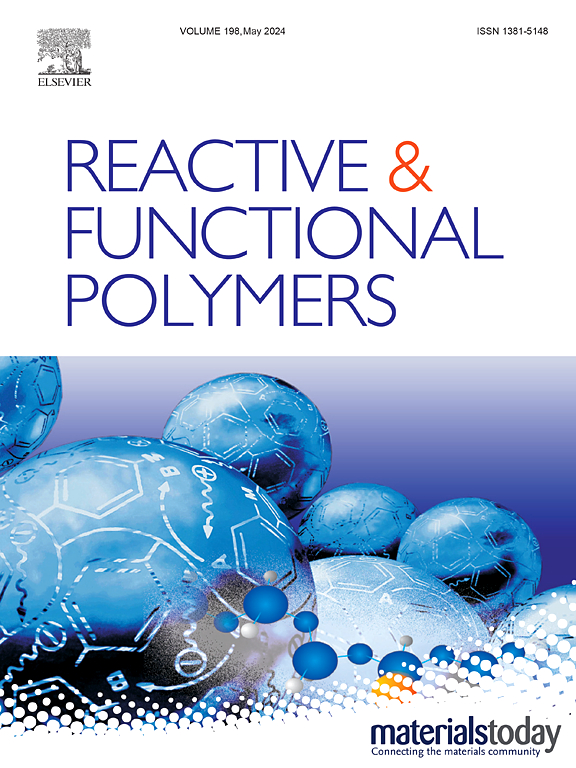Bio-based dicoumarin-containing benzoxazine resin: Synthesis, photo-thermal polymerization and thermal stability
IF 5.1
3区 工程技术
Q1 CHEMISTRY, APPLIED
引用次数: 0
Abstract
With the increasing awareness of environmental protection, considerable efforts are now devoted into bio-derived material fabrication. Through utilization of renewable biomass aligning with green chemistry principles, various sustainable materials have been prepared. In the current study, an innovative benzoxazine monomer containing dual coumarin moieties was successfully prepared through Mannich condensation using 4-methylumbelliferone (bio-phenolic precursor) and 7-amino-4-methylcoumarin (bio-amine component). The molecular architecture integrates photoreactive coumarin moieties, enabling dual photo-thermal curing capability. Structural validation via 1H/13C NMR and FT-IR spectroscopy confirmed the monomer integrity. Real-time UV–Vis spectroscopy monitoring indicated an 81 % conversion of the [2π + 2π] cycloaddition reaction following 2 h of UV irradiation (λ = 365 nm). The photopolymerized benzoxazine precursor shows a 5.4 °C curing temperature depression comparing to unphotopolymerized monomer. Complementary in-situ FT-IR analyses and DSC elucidated thermal-initiated ring-opening polymerization, demonstrating temperature-dependent conversion profiles. The polybenzoxazine prepared through photo-thermal polymerization shows higher thermal stability than solely thermal polymerized one. Through molecular design, this work realizes photo-thermal synergistic curing of bio-based benzoxazine resins, proposing an innovative approach to develop thermosetting materials that integrate low-energy processing, high heat resistance, and environmental sustainability.

生物基含二香豆素苯并恶嗪树脂:合成、光热聚合及热稳定性
随着人们对环境保护意识的增强,生物衍生材料的制造已成为人们关注的焦点。根据绿色化学原理,利用可再生生物质制备各种可持续材料。本研究以生物酚前体4-甲基伞草酮和生物胺组分7-氨基-4-甲基香豆素为原料,通过曼尼希缩合法制备了含有双香豆素基团的新型苯并杂嗪单体。分子结构集成光反应香豆素部分,使双光热固化能力。通过1H/13C NMR和FT-IR光谱进行结构验证,证实了单体的完整性。实时紫外-可见光谱监测表明,在紫外照射(λ = 365 nm) 2 h后,[2π + 2π]环加成反应的转化率为81%。光聚合的苯并恶嗪前驱体与未光聚合的单体相比,固化温度降低5.4℃。互补的原位FT-IR分析和DSC阐明了热引发的开环聚合,展示了温度依赖的转化曲线。光热聚合法制备的聚苯并恶嗪比单纯热聚合法制备的聚苯并恶嗪具有更高的热稳定性。本研究通过分子设计,实现了生物基苯并恶嗪树脂的光热协同固化,提出了一种集低能耗加工、高耐热性和环境可持续性为一体的热固性材料的创新方法。
本文章由计算机程序翻译,如有差异,请以英文原文为准。
求助全文
约1分钟内获得全文
求助全文
来源期刊

Reactive & Functional Polymers
工程技术-高分子科学
CiteScore
8.90
自引率
5.90%
发文量
259
审稿时长
27 days
期刊介绍:
Reactive & Functional Polymers provides a forum to disseminate original ideas, concepts and developments in the science and technology of polymers with functional groups, which impart specific chemical reactivity or physical, chemical, structural, biological, and pharmacological functionality. The scope covers organic polymers, acting for instance as reagents, catalysts, templates, ion-exchangers, selective sorbents, chelating or antimicrobial agents, drug carriers, sensors, membranes, and hydrogels. This also includes reactive cross-linkable prepolymers and high-performance thermosetting polymers, natural or degradable polymers, conducting polymers, and porous polymers.
Original research articles must contain thorough molecular and material characterization data on synthesis of the above polymers in combination with their applications. Applications include but are not limited to catalysis, water or effluent treatment, separations and recovery, electronics and information storage, energy conversion, encapsulation, or adhesion.
 求助内容:
求助内容: 应助结果提醒方式:
应助结果提醒方式:


